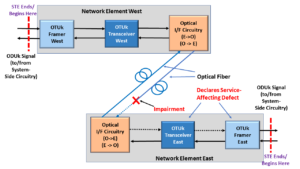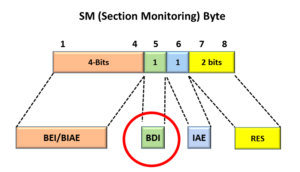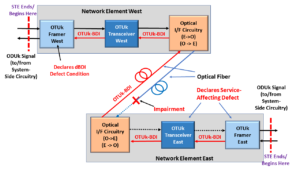What are Consequent Equations, and How Should You Interpret Them?
The purpose of this blog post is two-fold.
- To describe the concept of Consequent Equations and
- To discuss how we can use and interpret these Consequent Equations.
Introduction
Many ITU Standards (such as ITU-T G.798 for OTN Applications) will discuss many aspects of defects. These standards will define defects such as dAIS (Alarm Indication Signal) and dLOM (the Loss of Multi-frame).
These same standards will also define the criteria that an OTN Network Element (be it an STE or PTE) should use to declare or clear a given defect.
For example, ITU-T G.798 specifies all of the following defects that an OTN STE can declare and clear.
- dAIS – (OTUk-AIS)
- dLOS-P (Loss of Signal-Path Defect)
- dLOF – Loss of Frame Defect
- dLOM – Loss of Multi-Frame Defect
- dLOFLANE – Loss of Frame-Lane Signal (OTL3.4/OTL4.4/OTL4.10 Applications Only) (*)
- dLOL – Loss of Lane Alignment (OTL3.4/OTL4.4/OTL4.10 Applications Only)(*)
dIAE – Input Alignment Error Defect (*)dBIAE – Backward Input Alignment Error Defect (*)- dTIM – OTUk-Trace Identifier Mismatch Defect (*)
- dBDI – OTUk-Backward Defect Indicator Defect
- dDEG – OTUk-Signal Degrade Defect (*)
And that’s all well and good.
NOTE: (*) – Indicates that you need to be a member of THE BEST DARN OTN TRAINING PRESENTATION…PERIOD!!! to access these links.
How should an STE/PTE Respond Whenever it Declares a Defect?
However, what else should an STE do whenever it declares (for example) the dLOF defect condition?
Does this STE have a responsibility to notify other STEs of this defect?
Similarly, what else should a PTE do whenever it declares (for example) the dTIM (ODUk-TIM) defect condition?
Again, does this PTE have a responsibility to notify other nearby PTEs of this defect?
The short answer to both of these questions is, “Yes, for those specific defects that I mentioned, they do have a responsibility to notify upstream and downstream equipment of the occurrence of those defect conditions.”
However, to confuse things, the PTE/STE must notify upstream and downstream PTE/STE whenever some defects occur, but not others.
How Do We Sort out This Confusion?
The Answer: Consequent Equations.
Let’s assume that a certain STE is declaring the dLOF Defect condition, as shown below in Figure 1.

Figure 1, Illustration of the STE (e.g., the OTSi/OTUk-a_A_Sk Atomic Function) declares the dLOF defect condition.
What happens next?
At this point, let’s write down the Consequent Equation that pertains to this STE (or the OTSi/OTUk-a_A_Sk function in this case):
aSSF <- dLOS-P or dAIS or dLOF or dLOM or AI_TSF-P
Where:
aSSF is the current state of the CI_SSF output pin (of the OTSi/OTUk-a_A_Sk function).
dLOS-P is the current state of the Loss of Signal-Path Defect condition
dAIS is the current state of the OTUk-AIS Defect Condition
dLOF is the current state of the Loss of Frame Defect Condition
dLOM is the current state of the Loss of Multi-Frame Defect Condition, and
AI_TSF-P is the current (logical) state of the AI_TSF-P input pin (to the OTSi/OTUk-a_A_Sk atomic function).
This consequent equation states that the STE (or OTSi/OTUk-a_A_Sk function) will assert its CI_SSF output pin anytime it declares any of the following defect conditions:
dLOS -P – The Loss of Signal-Path Defect Condition- dAIS – The (OTUk-AIS) Defect Condition
- dLOF – The Loss of Frame Defect Condition
- dLOM – The Loss of Multi-Frame Defect Condition
This consequent equation also states that the STE (the OTSi/OTUk-a_A_Sk function) will assert the CI_SSF output pin anytime the upstream atomic function asserts the AI_TSF input to this function.
NOTE: Please see the OTSi/OTUk_A_Sk Function Post for more information about this particular Atomic Function.
So What Does All of This Mean?
In Figure 2, I show the OTSi/OTUk_A_Sk function now asserting its CI_SSF output pin because it is currently declaring the dLOF defect condition.

Figure 2, Illustration of the OTSi/OTUk_A_Sk Atomic Function asserting its CI_SSF output because it is currently declaring the dLOF defect condition.
Please note that the CI_SSF output (from the OTSi/OTUk_A_Sk function) is connected to the CI_SSF input of the (downstream) OTUk_TT_Sk function.
OK, that’s great. The above Consequent Equation states that the STE (e.g., the OTSi/OTUk_A_Sk function will assert the CI_SSF output pin whenever it declares the dLOF defect.
How does that alert any other STE/PTE of the OTSi/OTUk_A_Sk function declaring the dLOF defect?
Answer: There is more to this, and it involves more Consequent Equations.
Let’s Take a Look at the Downstream Circuitry
Let’s now look at the OTUk_TT_Sk and OTUk/ODUk_A_Sk Atomic Functions (which are both downstream from the OTSi/OTUk_A_Sk function).
In Figure 3, I show the OTUk_TT_Sk and the OTUk/ODUk_A_Sk Atomic Functions.
I also show that the upstream (OTSi/OTUk_A_Sk function) circuitry is now asserting the CI_SSF input (to the OTUk_TT_Sk function) – as we described above.

Figure 3, Illustration of the OTUk_TT_Sk and OTUk/ODUk_A_Sk functions – with upstream circuitry asserting the CI_SSF input pin.
Now, the OTUk_TT_Sk Atomic Function happens to have two sets of Consequent Equations:
I will list each of these equations below.
- aTSF <- CI_SSF or dAIS or (dTIM and (NOT TIMActDis))
- aBDI <- CI_SSF or dAIS or dTIM
I will explain each of these equations below.
The First Consequent Equation – OTUk_TT_Sk Function
Let’s start with the first Consequent Equation for the OTUk_TT_Sk function.
aTSF <- CI_SSF or dAIS or (dTIM and (NOT TIMActDis))
Where:
aTSF is the current state of the AI_TSF output of the OTUk_TT_Sk Atomic Function.
CI_SSF is the current state of the CI_SSF input of the OTUk_TT_Sk Atomic Function.
dAIS is the current state of the dAIS defect condition, and
dTIM is the current state of the Trail Trace Identifier Mismatch Defect Condition.
This Consequent Equation states that the OTUk_TT_Sk Atomic Function should assert the AI_TSF output signal anytime it declares any of the following defect conditions.
- dTIM – Trail Trace Identifier Mismatch Defect
- dAIS – AIS Defect
This Consequent Equation also states that the OTUk_TT_Sk function should assert the AI_TSF output whenever the upstream circuitry (e.g., the OTSi/OTUk_A_Sk function) asserts the CI_SSF input pin.
In Figure 4, I show the OTUk_TT_Sk function asserting its AI_TSF output pin because the upstream OTSi/OTUk_A_Sk function is asserting the CI_SSF input pin (to this function).

Figure 4, The OTUk_TT_Sk Atomic Function asserts the AI_TSF output pin because the upstream OTSi/OTUk_A_Sk function is asserting its CI_SSF input pin.
OK, now let’s look at the second Consequent Equation for the OTUk_TT_Sk Function.
The Second Consequent Equation – OTUk_TT_Sk Function
aBDI <- CI_SSF or dAIS or dTIM
Where:
aBDI is the state of the RI_BDI output (of the Remote Port Interface) of the OTUk_TT_Sk function.
Earlier in this post, we have defined CI_SSF, dAIS, and dTIM.
Therefore, this Consequent Equation states that the OTUk_TT_Sk function will assert the RI_BDI output pin anytime it declares the dAIS or dTIM defect conditions.
This equation also states that the OTUk_TT_Sk function will also assert the RI_BDI output pin anytime the upstream circuitry asserts the CI_SSF input (to the OTUk_TT_Sk function).
If you recall from the OTUk_TT_So and OTUk_TT_Sk posts, I state that anytime the OTUk_TT_Sk function asserts the RI_BDI output pin, it will command its collocated OTUk_TT_So function to transmit the OTUk-BDI indicator back out to the remote end.
I show this phenomenon below in Figure 5.

Figure 5, The OTUk_TT_Sk function asserts its RI_BDI output pin, commanding its Collocated OTUk_TT_So function to transmit the BDI (Backward Defect Indicator) back to the upstream STE because its CI_SSF is being driven HIGH.
Figure 5 shows that because the STE (OTSi/OTUk_A_Sk function) declared the dLOF defect, the downstream OTUk_TT_Sk function responded by commanding its collocated OTUk_TT_So function to transmit the OTUk-BDI indicator back to the upstream STE (the source of the defective OTUk signal).
However, we’re not done yet.
Since the OTUk_TT_Sk function is also asserting its AI_TSF output, it is also asserting the AI_TSF input to the (down-stream) OTUk/ODUk_A_Sk atomic function.
Has Inflation got You Down? Our Price Discounts Can Help You Fight Inflation and Help You to Become an Expert at OTN!!! Click Below to Learn More!!
Let’s move on to the OTUk/ODUk_A_Sk Atomic Function
As you can see in Figure 5, the OTUk_TT_Sk function, by asserting its AI_TSF output pin, is also asserting the AI_TSF input pin to the OTUk/ODUk_A_Sk function.
And the OTUk/ODUk_A_Sk function comes with several Consequent Equations of its own.
- aSSF <- AI_TSF and (not MI_AdminState = LOCKED), and
- aAIS <- AI_TSF and (not MI_AdminState = LOCKED)
Let’s take each of these equations, one at a time.
The First Consequent Equation – OTUk/ODUk_A_Sk Function
aSSF <- AI_TSF and (not MI_AdminState = LOCKED)
Where:
AI_TSF is the current state of the AI_TSF input pin to the OTUk/ODUk_A_Sk function, and
MI_AdminState reflects the current state of the MI_AdminState input signal (which the System Operator can set).
This Consequent Equation states that the OTUk/ODUk_A_Sk function will automatically assert its CI_SSF output signal whenever the upstream circuitry asserts its AI_TSF input, provided that the System Operator has not put the OTUk/ODUk_A_Sk function into the LOCKED state.
In Figure 6, I show the OTUk/ODUk_A_Sk function asserting its CI_SSF output pin because the upstream circuitry is asserting its AI_TSF input pin.

Figure 6, The OTUk/ODUk_A_Sk function asserts its CI_SSF output pin because the upstream circuitry (e.g., the OTUk_TT_Sk and OTSi/OTUk_A_Sk functions) is asserting its AI_TSF input pin.
I should also point out that APS (Automatic Protection Switching) systems often trigger (and start protection switching) whenever the OTUk/ODUk_A_Sk function asserts its CI_SSF output pin.
Now, let’s move on to the next Consequent Equation.
The Second Consequent Equation – OTUk/ODUk_A_Sk Function
aAIS <- AI_TSF and (not MI_AdminState = LOCKED)
Where:
aAIS is the current state of the ODUk-AIS Maintenance Signal.
If aAIS = TRUE, then the OTUk/ODUk_A_Sk function is overwriting its output signal with the ODUk-AIS Maintenance signal.
Conversely, if aAIS is FALSE, then the OTUk/ODUk_A_Sk function transmits an ODUk data stream, carrying regular client traffic.
Therefore, this Consequent Equation states that the OTUk/ODUk_A_Sk function will transmit the ODUk-AIS Maintenance Signal anytime the upstream circuitry pulls its AI_TSF input TRUE; provided that the System Operator has NOT put the OTUk/ODUk_A_Sk function into the LOCKED State.
In Figure 7, I illustrate the OTUk/ODUk_A_Sk function transmitting the ODUk-AIS Maintenance Signal because upstream circuitry (e.g., the OTUk_TT_Sk and OTSi/OTUk_A_Sk functions) is asserting its AI_TSF input.

Figure 7, The OTUk/ODUk_A_Sk function replaces the ODUk signal (carrying client data) with the ODUk-AIS Maintenance Signal whenever upstream circuitry asserts its AI_TSF input.
So What Does All This Mean?
If we were to combine the OTSi/OTUk_A_Sk function, the OTUk_TT_Sk function, its Collocated OTUk_TT_So function, and the OTUk/ODUk_A_Sk function into a single box, that we call OTN STE.
Then, we could state that if the OTN STE declares the dLOF defect (as we discussed earlier in this post), then that same OTN STE will do all of the following:
- It will transmit the OTUk-BDI indicator back towards the upstream STE.
- The OTN STE will also replace the missing (or defective) ODUk data stream (carrying client traffic) with the ODUk-AIS Maintenance Signal, and
- It will also trigger APS (Automatic Protection Switching) activities by asserting the CI_SSF output (from the OTUk/ODUk_A_Sk function).
I show a drawing of these actions below in Figure 8.

Figure 8, Illustration of the OTN STE responding to the dLOF Defect Condition
Conclusion
Thanks to Consequent Equations, we can define and predict how an OTN STE or PTE will respond to certain defects.
I have presented Consequent Equations in each post pertaining to OTN Atomic Functions.
Clueless about OTN? We Can Help!! Click on the Banner Below to Learn More.
Discounts Available for a Short Time!!!
Click on the Image below to See More OTN- or Protection-Switching-Related Posts

OTN Related Topics within this Blog




















